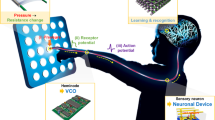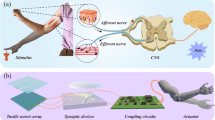Abstract
Interpreting and tracking finger motion in free space is of use in the development of control interfaces for augmented and virtual reality systems. One approach to create human–machine interfaces capable of accurate finger motion recognition is to use wearable sensors with integrated neuromorphic computing. Here we show that an integrated titanium-oxide-based artificial synapse array and organic motion sensor can be conformably attached to a finger and provide real-time motion recognition. The synaptic device and sensor exhibit well-defined synaptic and light-responsive electrical properties, respectively, as well as flexibility and mechanical robustness. The integrated synapses–sensor enables optical–electrical signal conversion and summation of post-synaptic current. Finger motions for time-resolved digit patterns (0–9) can be learned and recognized with an accuracy of up to 95% at varying strains and up to 100 strain cycles.
This is a preview of subscription content, access via your institution
Access options
Access Nature and 54 other Nature Portfolio journals
Get Nature+, our best-value online-access subscription
$29.99 / 30 days
cancel any time
Subscribe to this journal
Receive 12 digital issues and online access to articles
$119.00 per year
only $9.92 per issue
Buy this article
- Purchase on Springer Link
- Instant access to full article PDF
Prices may be subject to local taxes which are calculated during checkout




Similar content being viewed by others
Data availability
The data that support the findings of this study are available from the corresponding authors upon reasonable request.
References
Nguyen, H. T. & Kendon, A. Gesture: visible action as utterance. Crit. Inq. Lang. Stud. 5, 72–77 (2008).
Morris, D. Gestures: Their Origins and Distribution (Jonathan Cape, 1979).
Postolache, O. et al. Remote monitoring of physical rehabilitation of stroke patients using IoT and virtual reality. IEEE J. Sel. Areas Commun. 39, 562–573 (2021).
Jung, W. & Lee, H. G. Energy–accuracy aware finger gesture recognition for wearable IoT devices. Sensors 22, 4801 (2022).
Moin, A. et al. A wearable biosensing system with in-sensor adaptive machine learning for hand gesture recognition. Nat. Electron. 4, 54–63 (2021).
Alam, M. S. et al. Trajectory-based air-writing recognition using deep neural network and depth sensor. Sensors 20, 376 (2020).
Zhou, Z. et al. Sign-to-speech translation using machine-learning-assisted stretchable sensor arrays. Nat. Electron. 3, 571–578 (2020).
Linderman, M., Lebedev, M. A. & Erlichman, J. S. Recognition of handwriting from electromyography. PLoS ONE 4, e6791 (2009).
Mystakidis, S. Metaverse. Encyclopedia 2, 486–497 (2022).
Zhu, M. et al. Haptic-feedback smart glove as a creative human-machine interface (HMI) for virtual/augmented reality applications. Sci. Adv. 6, eaaz8693 (2020).
Shneiderman, B. Direct manipulation: a step beyond programming languages. Computer 16, 57–69 (1983).
Sinha, G., Shahi, R. & Shankar, M. Human computer interaction. In Proc. 2010 3rd International Conference on Emerging Trends in Engineering and Technology 1–4 (IEEE Computer Society, 2010).
Park, Y. & Bae, J. A three-dimensional finger motion measurement system of a thumb and an index finger without a calibration process. Sensors 20, E756 (2020).
Joseph, V., Talpade, A., Suvarna, N. & Mendonca, Z. Visual gesture recognition for text writing in air. In 2018 Second International Conference on Intelligent Computing and Control Systems (ICICCS) 23–26 (IEEE, 2018).
Yana, B. & Onoye, T. Real-time air-writing recognition in motion stream. In International Workshop on Advanced Image Technology (IWAIT) 2019 11049, 69–74 (SPIE, 2019).
Amma, C., Georgi, M. & Schultz, T. Airwriting: hands-free mobile text input by spotting and continuous recognition of 3D-space handwriting with inertial sensors. In 2012 16th International Symposium on Wearable Computers 52–59 (IEEE, 2012).
Guo, L., Lu, Z. & Yao, L. Human-machine interaction sensing technology based on hand gesture recognition: a review. IEEE Trans. Human-Mach. Syst. 51, 300–309 (2021).
Oh, S. et al. Flexible artificial Si-In-Zn-O/ion gel synapse and its application to sensory-neuromorphic system for sign language translation. Sci. Adv. 7, eabg9450 (2021).
Lee, Y. et al. Stretchable organic optoelectronic sensorimotor synapse. Sci. Adv. 4, eaat7387 (2018).
Araromi, O. A. et al. Ultra-sensitive and resilient compliant strain gauges for soft machines. Nature 587, 219–224 (2020).
Wang, M. et al. Gesture recognition using a bioinspired learning architecture that integrates visual data with somatosensory data from stretchable sensors. Nat. Electron. 3, 563–570 (2020).
Sengupta, D., Mastella, M., Chicca, E. & Kottapalli, A. G. P. Skin-inspired flexible and stretchable electrospun carbon nanofiber sensors for neuromorphic sensing. ACS Appl. Electron. Mater. 4, 308–315 (2022).
Kim, K. K. et al. A deep-learned skin sensor decoding the epicentral human motions. Nat. Commun. 11, 2149 (2020).
Yamada, T. et al. A stretchable carbon nanotube strain sensor for human-motion detection. Nat. Nanotechnol. 6, 296–301 (2011).
Lü, X. et al. High sensitivity flexible electronic skin based on graphene film. Sensors 19, 794 (2019).
Zhao, J., Zhang, M., Wan, S., Yang, Z. & Hwang, C. S. Highly flexible resistive switching memory based on the electronic switching mechanism in the Al/TiO2/Al/polyimide structure. ACS Appl. Mater. Interfaces 10, 1828–1835 (2018).
Molina-Lopez, F. et al. Inkjet-printed stretchable and low voltage synaptic transistor array. Nat. Commun. 10, 2676 (2019).
Yokota, T. et al. Ultraflexible organic photonic skin. Sci. Adv. 2, e1501856 (2016).
Jeong, J.-W. et al. Materials and optimized designs for human-machine interfaces via epidermal electronics. Adv. Mater. 25, 6839–6846 (2013).
Yang, J. J., Strukov, D. B. & Stewart, D. R. Memristive devices for computing. Nat. Nanotechnol. 8, 13–24 (2013).
Jang, J. et al. A learning-rate modulable and reliable TiOx memristor array for robust, fast, and accurate neuromorphic computing. Adv. Sci. 9, 2201117 (2022).
Kim, S. H. et al. A bioinspired stretchable sensory-neuromorphic system. Adv. Mater. 33, 2104690 (2021).
Abbott, L. F. & Regehr, W. G. Synaptic computation. Nature 431, 796–803 (2004).
Neves, G., Cooke, S. F. & Bliss, T. V. P. Synaptic plasticity, memory and the hippocampus: a neural network approach to causality. Nat. Rev. Neurosci. 9, 65–75 (2008).
Kim, D.-H. et al. Epidermal electronics. Science 333, 838–843 (2011).
Liu, Y., Pharr, M. & Salvatore, G. A. Lab-on-skin: a review of flexible and stretchable electronics for wearable health monitoring. ACS Nano 11, 9614–9635 (2017).
Kim, S., Lim, M., Kim, Y., Kim, H.-D. & Choi, S.-J. Impact of synaptic device variations on pattern recognition accuracy in a hardware neural network. Sci. Rep. 8, 2638 (2018).
Choi, S. et al. A self-rectifying TaOy/nanoporous TaOx memristor synaptic array for learning and energy-efficient neuromorphic systems. npg Asia Mater. 10, 1097–1106 (2018).
Cho, B., Song, S., Ji, Y., Kim, T.-W. & Lee, T. Organic resistive memory devices: performance enhancement, integration, and advanced architectures. Adv. Funct. Mater. 21, 2806–2829 (2011).
Pang, C. L. Strain and stress effects on single crystal-supported titania and related nanostructures. Semicond. Sci. Technol. 35, 113001 (2020).
Gao, W., Ota, H., Kiriya, D., Takei, K. & Javey, A. Flexible electronics toward wearable sensing. Acc. Chem. Res. 52, 523–533 (2019).
He, Z. et al. Single-junction polymer solar cells with high efficiency and photovoltage. Nat. Photon. 9, 174–179 (2015).
Hall, R. N. Electron-hole recombination in germanium. Phys. Rev. 87, 387–387 (1952).
Shockley, W. & Read, W. T. Statistics of the recombinations of holes and electrons. Phys. Rev. 87, 835–842 (1952).
Park, S. et al. Ultraflexible near-infrared organic photodetectors for conformal photoplethysmogram sensors. Adv. Mater. 30, 1802359 (2018).
Fukuhara, T., Tamai, Y. & Ohkita, H. Nongeminate charge recombination in organic photovoltaics. Sustain. Energy Fuels 4, 4321–4351 (2020).
Proctor, C. M., Kuik, M. & Nguyen, T.-Q. Charge carrier recombination in organic solar cells. Prog. Polym. Sci. 38, 1941–1960 (2013).
Liu, X. et al. Regular organic solar cells with efficiency over 10% and promoted stability by ligand- and thermal annealing-free Al-doped ZnO cathode interlayer. Adv. Sci. 4, 1700053 (2017).
Lee, H. et al. Stretchable organic optoelectronic devices: design of materials, structures, and applications. Mater. Sci. Eng. R. Rep. 146, 100631 (2021).
Fukuda, K., Yu, K. & Someya, T. The future of flexible organic solar cells. Adv. Energy Mater. 10, 2000765 (2020).
Wu, H. & Gu, X. Towards dropout training for convolutional neural networks. Neural Netw. 71, 1–10 (2015).
Karystinos, G. N. & Pados, D. A. On overfitting, generalization, and randomly expanded training sets. IEEE Trans. Neural Netw. 11, 1050–1057 (2000).
Srivastava, N., Hinton, G., Krizhevsky, A., Sutskever, I. & Salakhutdinov, R. Dropout: a simple way to prevent neural networks from overfitting. J. Mach. Learn. Res. 15, 1929–1958 (2014).
Vincent, P., Larochelle, H., Bengio, Y. & Manzagol, P.-A. Extracting and composing robust features with denoising autoencoders. In Proc. 25th International Conference on Machine Learning 1096–1103 (ACM, 2008).
Lotfi, A. & Benyettou, A. Over-fitting avoidance in probabilistic neural networks. In 2015 World Congress on Information Technology and Computer Applications (WCITCA) 1–6 (IEEE, 2015).
Park, S. et al. Self-powered ultra-flexible electronics via nano-grating-patterned organic photovoltaics. Nature 561, 516–521 (2018).
Acknowledgements
This work was supported by the National Research Foundation of Korea (NRF-2022R1A2B5B02001455, NRF-2022M3H4A1A01009526, NRF-2022K2A9A1A01098066, RS-2023-00220077, RS-2023-00213089 and 2022R1I1A1A01073911); the KU-KIST Research Fund, the Korea University Research Grant, the MSIT, Korea, under the ITRC (Information Technology Research Center) support program (grant no. IITP-2023-2020-0-01461) supervised by the Institute for Information & Communications Technology Planning & Evaluation (IITP); and the Technology Innovation Program (grant no. RS-2022-00154781) funded by the Ministry of Trade, Industry & Energy (MOTIE, Korea). We would like to express our gratitude to B.-G. Lee from Gwangju Institute of Science and Technology and S. Gi from Korea Electronics Technology Institute for their valuable contributions in reviewing and providing insightful feedback on circuit designs.
Author information
Authors and Affiliations
Contributions
G.W. and S.P. conceived the idea for this work. H.C., I.L., J.J., S.P. and G.W. designed the experiments and wrote the manuscript. H.C. fabricated the TOAS sample and conducted the related electrical and mechanical experiments. I.L., H.L. and J.-H.K. fabricated the ultrathin substrate and OPS sample and conducted the related experiments, including acquiring the digit patterns. J.J. conducted the neural network simulations. G.W. and S.P. oversaw the project, revised the manuscript and led the effort to completion.
Corresponding authors
Ethics declarations
Competing interests
The authors declare no competing interests.
Peer review
Peer review information
Nature Electronics thanks Tse Nga Ng and the other, anonymous, reviewer(s) for their contribution to the peer review of this work.
Additional information
Publisher’s note Springer Nature remains neutral with regard to jurisdictional claims in published maps and institutional affiliations.
Supplementary information
Supplementary Information
Supplementary Notes 1–5, Figs. 1–43, Tables 1 and 2 and references.
Supplementary Video 1
Detachment of the ultrathin TOAS array device from glass support.
Supplementary Video 2
Ultraflexibility of the TOAS array device.
Supplementary Video 3
Transfer of TOAS array device on the elastomer.
Supplementary Video 4
Mechanical endurance test of the ultraflexible TOAS array device.
Rights and permissions
Springer Nature or its licensor (e.g. a society or other partner) holds exclusive rights to this article under a publishing agreement with the author(s) or other rightsholder(s); author self-archiving of the accepted manuscript version of this article is solely governed by the terms of such publishing agreement and applicable law.
About this article
Cite this article
Cho, H., Lee, I., Jang, J. et al. Real-time finger motion recognition using skin-conformable electronics. Nat Electron 6, 619–629 (2023). https://doi.org/10.1038/s41928-023-01012-z
Received:
Accepted:
Published:
Issue Date:
DOI: https://doi.org/10.1038/s41928-023-01012-z
This article is cited by
-
Memory-electroluminescence for multiple action-potentials combination in bio-inspired afferent nerves
Nature Communications (2024)
-
Integrated devices that can recognize hand gestures
Nature Electronics (2023)



